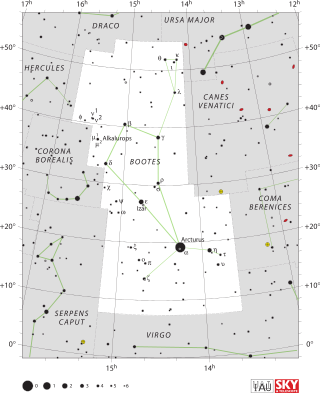Top Qs
Timeline
Chat
Perspective
Theta Boötis
Star in the northern constellation of Boötes From Wikipedia, the free encyclopedia
Remove ads
Theta Boötis is a star in the northern constellation of Boötes the herdsman, forming a corner of the upraised left hand of this asterism.[13] Its name is a Bayer designation that is Latinized from θ Boötis, and abbreviated Theta Boo or θ Boo. This star has the traditional name Asellus Primus, pronounced /əˈsɛləs ˈpraɪməs/, which is Latin for "first donkey colt".[13] Faintly visible to the naked eye, this star has a yellow-white hue with an apparent visual magnitude of 4.05.[2] It is located at a distance of 47.2 light-years (14.5 pc) from the Sun based on parallax measurements,[1] but is drifting closer with a radial velocity of −10.6 km/s.[5] It has a relatively high proper motion, traversing the celestial sphere at the rate of 0.464 arc seconds per annum.[14]
Remove ads
Properties
Summarize
Perspective

The stellar classification of Theta Boötis is F7 V,[2] matching an F-type main-sequence star. It is a solar-type star that may be near the end of its main sequence lifetime based on a high luminosity for a star of its type.[10] Theta Boötis is a suspected variable star[15] and a source of X-ray emission.[16] There is evidence for low amplitude radial velocity variation of about 5 km/s.[10] The star has a magnetic field with a mean longitudinal strength of 147±59 Gauss.[17]
Theta Boötis has a 23% greater mass and a 73% larger radius than the Sun.[7] It is about 3–4 billion years old and is spinning with a projected rotational velocity of 29 km/s.[9] The star is radiating 4.2 times the luminosity of the Sun[18] from its photosphere at an effective temperature of 6,290 K.[7] Based on the proportion of iron found in the stellar spectrum, this star has a near-solar abundance of elements with mass greater than helium.[8]
There is a nearby 11th magnitude optical companion star about 70 arcseconds away. This is a class M2.5 red dwarf that is separated by a minimum of 1,000 AU. It is uncertain whether they are gravitationally bound, but they do have a common motion through space and so the two stars probably share a common origin.[19][3]
Remove ads
Nomenclature
θ Boötis, along with the other Aselli (ι Boo and κ Boo) and λ Boo, were Aulād al Dhiʼbah (أولاد الضّباع - awlād al-ḍibā), "the Whelps of the Hyenas".[13]
In Chinese, 天枪 (Tiān Qiāng), meaning Celestial Spear, refers to an asterism consisting of θ Boötis, κ2 Boötis and ι Boötis.[20] Consequently, the Chinese name for θ Boötis itself is 天枪三 (Tiān Qiāng sān, English: the Third Star of Celestial Spear.)[21]
Remove ads
References
External links
Wikiwand - on
Seamless Wikipedia browsing. On steroids.
Remove ads

